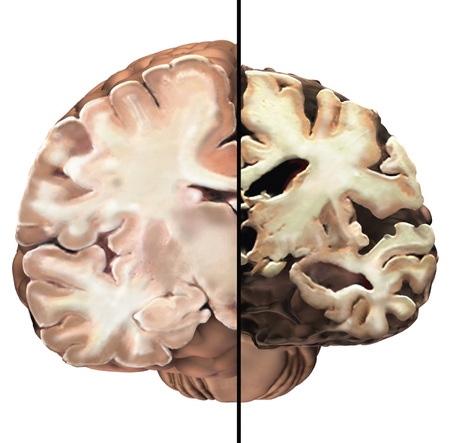Confusion and Dementia
Objectives
• Define the key terms and key abbreviations in this chapter.
• Describe confusion and its causes.
• List the measures that help confused persons.
• Explain the differences between delirium, depression, and dementia.
• Describe the signs, symptoms, and behaviors of Alzheimer’s disease (AD).
• Explain the care required by persons with AD and other dementias.
• Describe the effects of AD on the family.
• Explain how to promote PRIDE in the person, the family, and yourself.
Key Terms
Changes in the brain and nervous system occur with aging and certain diseases (Box 49-1, p. 770). Cognitive function may be affected. (Cognitive relates to knowledge.) Quality of life is affected. Cognitive function involves memory, thinking, reasoning, ability to understand, judgment, and behavior.
Confusion
Confusion is a mental state of being disoriented to person, time, place, situation, or identity. Disoriented means to be apart from (dis) one’s awareness (oriented). Disease, brain injury, infections, hearing and vision loss, and drug side effects are some causes of confusion. Reduced blood flow to the brain with aging can cause personality and mental changes.
With confusion, memory and ability to make good judgments are lost. A person may not know people, the time, or the place. Daily activities may be affected. Behavior changes are common—anger, restlessness, depression, irritability.
Treatment is aimed at the cause. Confusion may be temporary or permanent. Some measures help improve function (Box 49-2, p. 770). You must meet the person’s basic needs.
Delirium
Delirium is a state of sudden, severe confusion and rapid changes in brain function. Usually temporary and reversible, it occurs with physical or mental illness. Causes include acute or chronic illness, surgery, drug or alcohol abuse, drug side effects, and infections. Delirium often lasts for about 1 week. However, it may take several weeks for normal mental function to return.
Delirium signals physical illness. It is an emergency. The cause must be found and treated. See Box 49-3 for signs and symptoms.
Dementia
Dementia is the loss of cognitive function that interferes with routine personal, social, and occupational activities. (De means from. Mentia means mind.) Changes in personality, mood, behavior, and communication are common. Dementia is a group of symptoms, not a specific disease.
Dementia is caused by damage to brain cells. Causes are listed in Box 49-4. Some dementias can be reversed. When the cause is removed, so are the signs and symptoms. Permanent dementias result from changes in the brain. There is no cure. Function declines over time.
Dementia is not a normal part of aging. Most older people do not have dementia. Early warning signs include:
• Memory loss (losing things, forgetting names)
• Problems with common tasks (for example, dressing, cooking, driving)
• Problems with language and communication; forgetting simple words
• Getting lost in familiar places
• Misplacing things and putting things in odd places (for example, putting a watch in the oven)
• Personality, mood, and behavior changes
• Poor or decreased judgment (for example, going outdoors in the snow without shoes)
Pseudodementia means false (pseudo) dementia. The person has signs and symptoms of dementia. However, there are no changes in the brain. This can occur with delirium and depression. Both can be mistaken for dementia.
See Focus on Children and Older Persons: Dementia.
Mild Cognitive Impairment
Mild cognitive impairment (MCI) causes slight changes in memory, language, thinking, and judgment. Changes are greater than those with normal aging. The person or others may notice problems. However, the problems do not interfere with daily life. The person is at risk for dementia.
Alzheimer’s Disease
Alzheimer’s disease (AD) is the most common type of permanent dementia. Many brain cells are destroyed and die. Over time, the brain shrinks from nerve cell death and tissue loss (Fig. 49-2). Two abnormal structures are thought to cause damage.
• Plaques—protein pieces that build up in the spaces between nerve cells.
• Tangles—twisted protein fibers that build up inside cells.

With aging, most people develop some plaques and tangles. In people with AD, plaque and tangle development is severe. Memory areas of the brain are often affected before other areas.
The onset of AD is gradual. Usually symptoms first appear after age 60. Persons with AD can live for 3 to 10 years or longer. More persons with AD are women because women live longer than men.
AD is not a normal part of aging. However, the greatest risk factor is increasing age. The risk increases after age 65. Nearly half the people aged 85 and older have AD. A family history of AD increases the risk of developing the disease.
Signs of AD
According to the Alzheimer’s Association, the most common early symptom of AD is difficulty remembering newly learned information. The classic sign is a gradual loss of short-term memory. At first, the only symptom may be forgetfulness.
With AD there is a slow, steady decline in mental functions, including:
The person has problems with work and everyday functions. Problems with family and social relationships occur.
Box 49-5 lists the warning and other signs of AD. See Box 49-6 for the differences between AD and normal age-related changes.
Behaviors and Changes in Function
AD changes how a person behaves and acts. Besides the signs and symptoms in Boxes 49-5 and 49-7, these behaviors and changes are common.
• Paranoia
• Catastrophic reactions (p. 776)
• Agitation and aggression (p. 776)
• Communication changes (p. 776)
• Repetitive behaviors (p. 777)
• Rummaging and hiding things (p. 777)
Besides changes in the brain, the following can affect the person’s behavior.
• Emotions—sadness, fear, feeling overwhelmed, stress, anxiety
• Problems in the person’s setting:
• A strange setting. The person does not know the setting well.
• Too much noise (TV, radio, music, people talking at once) can cause confusion and frustration.
• Not understanding signs. The person may think that a WET FLOOR sign means to urinate on the floor.
• Mirrors. The person may think that a mirror image is another person in the room.
See Promoting Safety and Comfort: Behaviors and Changes in Function.
Wandering and Getting Lost.
Persons with AD are not oriented to person, time, and place. They may wander away and not find their way back. Wandering may be by foot, car, bike, or other means. They may be with you one moment and gone the next.
Judgment is poor. They cannot tell what is safe or dangerous. Life-threatening accidents are great risks. They can walk into traffic or into a nearby river, lake, ocean, or forest. If not properly dressed, heat or cold exposure is a risk.
Wandering may have no cause. Or the person may be looking for something or someone—the bathroom, the bedroom, a child, or a partner. Pain, drug side effects, stress, restlessness, too much stimulation, and anxiety are possible causes. A wandering pattern may be linked to a life-long routine—leaving work, getting children from school, and so on. Sometimes finding the cause prevents wandering.
See Teamwork and Time Management: Wandering and Getting Lost.
MedicAlert® + Alzheimer’s Association Safe Return®.
MedicAlert® + Alzheimer’s Association Safe Return® is a 24-hour emergency service for persons who wander or have a medical emergency. The program is nationwide.
The purpose is to find and safely return persons who wander and become lost. A small fee is charged. A family member completes a form and provides a photo. These are entered into a national database. The person receives an ID (wallet card and bracelet or necklace).
When reported missing, the person’s information is sent to the police. When the person is found, someone calls the toll-free number on the ID. MedicAlert® + Alzheimer’s Association Safe Return® then calls the family member or caregiver. The person is returned home safely.
Sundowning.
With sundowning, signs, symptoms, and behaviors of AD increase during hours of darkness. As daylight ends and darkness starts, confusion and restlessness increase. So do anxiety, agitation, and other symptoms. Behavior is worse after the sun goes down. It may continue throughout the night.
Sundowning may relate to being tired or hungry. Poor light and shadows may cause the person to see things that are not there. The person may be afraid of the dark.
Stay updated, free articles. Join our Telegram channel

Full access? Get Clinical Tree







